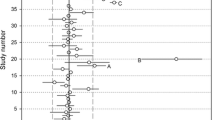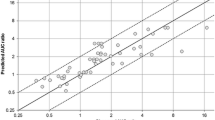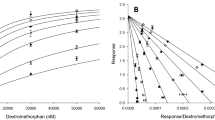Abstract
Background
Mechanistic static pharmacokinetic (MSPK) models are simple, have fewer data requirements, and have broader applicability; however, they cannot use in vitro information and cannot distinguish the contributions of multiple cytochrome P450 (CYP) isoenzymes and the hepatic and intestinal first-pass effects appropriately. We aimed to establish a new MSPK analysis framework for the comprehensive prediction of drug interactions (DIs) to overcome these disadvantages.
Methods
Drug interactions that occurred by inhibiting CYP1A2, CYP2C9, CYP2C19, CYP2D6, and CYP3A in the liver and CYP3A in the intestine were simultaneously analyzed for 59 substrates and 35 inhibitors. As in vivo information, the observed changes in the area under the concentration-time curve (AUC) and elimination half-life (t1/2), hepatic availability, and urinary excretion ratio were used. As in vitro information, the fraction metabolized (fm) and the inhibition constant (Ki) were used. The contribution ratio (CR) and inhibition ratio (IR) for multiple clearance pathways and hypothetical volume (VHyp) were inferred using the Markov Chain Monte Carlo (MCMC) method.
Result
Using in vivo information from 239 combinations and in vitro 172 fm and 344 Ki values, changes in AUC, and t1/2 were estimated for all 2065 combinations, wherein the AUC was estimated to be more than doubled for 602 combinations. Intake-dependent selective intestinal CYP3A inhibition by grapefruit juice has been suggested. By separating the intestinal contributions, DIs after intravenous dosing were also appropriately inferred.
Conclusion
This framework would be a powerful tool for the reasonable management of various DIs based on all available in vitro and in vivo information.






Similar content being viewed by others
References
Guideline on drug interaction for drug development and appropriate provision of information. https://www.pmda.go.jp/files/000228122.pdf
Sugano K. Lost in modelling and simulation? ADMET DMPK. 2021;9(2):75–109.
Min JS, Bae SK. Prediction of drug-drug interaction potential using physiologically based pharmacokinetic modeling. Arch Pharm Res. 2017;40(12):1356–79.
Li R, Barton HA, Yates PD, Ghosh A, Wolford AC, Riccardi KA, Maurer TS. A “middle-out” approach to human pharmacokinetic predictions for OATP substrates using physiologically-based pharmacokinetic modeling. J Pharmacokinet Pharmacodyn. 2014;41(3):197–209.
Tsamandouras N, Rostami-Hodjegan A, Aarons L. Combining the “bottom up” and “top down” approaches in pharmacokinetic modelling: fitting PBPK models to observed clinical data. Br J Clin Pharmacol. 2015;79(1):48–55.
Yoshida K, Guo C, Sane R. Quantitative prediction of OATP-mediated drug–drug interactions with model-based analysis of endogenous biomarker kinetics. CPT Pharmacomet Syst Pharmacol. 2018;7(8):517–24.
Yoshikado T, Toshimoto K, Maeda K, Kusuhara H, Kimoto E, Rodrigues AD, Chiba K, Sugiyama Y. PBPK modeling of coproporphyrin I as an endogenous biomarker for drug interactions involving inhibition of hepatic OATP1B1 and OATP1B3. CPT Pharmacomet Syst Pharmacol. 2018;7(11):739–47.
Yoshida K, Maeda K, Konagaya A, Kusuhara H. Accurate estimation of in vivo inhibition constants of inhibitors and fraction metabolized of substrates with physiologically based pharmacokinetic drug–drug interaction models incorporating parent drugs and metabolites of substrates with cluster newton method. Drug Metab Dispos. 2018;46(11):1805–16.
Schlender JF, Teutonico D, Coboeken K, Schnizler K, Eissing T, Willmann S, Jaehde U, Stass H. A physiologically-based pharmacokinetic model to describe ciprofloxacin pharmacokinetics over the entire span of life. Clin Pharmacokinet. 2018;57(12):1613–34.
Ke AB, Rostami-Hodjegan A, Zhao P, Unadkat JD. Pharmacometrics in pregnancy: an unmet need. Annu Rev Pharmacol Toxicol. 2014;54:53–69.
Feng S, Shi J, Parrott N, Hu P, Weber C, Martin-Facklam M, Saito T, Peck R. Combining “bottom-up” and “top-down” methods to assess ethnic difference in clearance: bitopertin as an example. Clin Pharmacokinet. 2016;55(7):823–32.
Doki K, Neuhoff S, Rostami-Hodjegan A, Homma M. Assessing potential drug-drug interactions between dabigatran etexilate and a P-glycoprotein inhibitor in renal impairment populations using physiologically based pharmacokinetic modeling. CPT Pharmacomet Syst Pharmacol. 2019;8(2):118–26.
Tylutki Z, Polak S, Wiśniowska B. Top-down, bottom-up and middle-out strategies for drug cardiac safety assessment via modeling and simulations. Curr Pharmacol Rep. 2016;2(4):171–7.
Ohno Y, Hisaka A, Suzuki H. General framework for the quantitative prediction of CYP3A4-mediated oral drug interactions based on the AUC increase by coadministration of standard drugs. Clin Pharmacokinet. 2007;46(8):681–96.
Ohno Y, Hisaka A, Ueno M, Suzuki H. General framework for the prediction of oral drug interactions caused by CYP3A4 induction from in vivo information. Clin Pharmacokinet. 2008;47(10):669–80.
Gabriel L, Tod M, Goutelle S. Quantitative prediction of drug interactions caused by CYP1A2 inhibitors and inducers. Clin Pharmacokinet. 2016;55(8):977–90.
Di Paolo V, Ferrari FM, Poggesi I, Quintieri L. Quantitative prediction of drug interactions caused by cytochrome P450 2B6 inhibition or induction. Clin Pharmacokinet. 2022;61(9):1297–306.
Tod M, Bourguignon L, Bleyzac N, Goutelle S. Quantitative prediction of interactions mediated by transporters and cytochromes: application to organic anion transporting polypeptides, breast cancer resistance protein and cytochrome 2C8. Clin Pharmacokinet. 2020;59(6):757–70.
Castellan AC, Tod M, Gueyffier F, Audars M, Cambriels F, Kassaï B, Nony P, Genophar Working Group. Quantitative prediction of the impact of drug interactions and genetic polymorphisms on cytochrome P450 2C9 substrate exposure. Clin Pharmacokinet. 2013;52(3):199–209.
Goutelle S, Bourguignon L, Bleyzac N, Berry J, Clavel-Grabit F, Tod M. In vivo quantitative prediction of the effect of gene polymorphisms and drug interactions on drug exposure for CYP2C19 substrates. AAPS J. 2013;15(2):415–26.
Tod M, Goutelle S, Clavel-Grabit F, Nicolas G, Charpiat B. Quantitative prediction of cytochrome P450 (CYP) 2D6-mediated drug interactions. Clin Pharmacokinet. 2011;50(8):519–30.
Tod M, Goutelle S, Bleyzac N, Bourguignon L. A generic model for quantitative prediction of interactions mediated by efflux transporters and cytochromes: application to P-glycoprotein and cytochrome 3A4. Clin Pharmacokinet. 2019;58(4):503–23.
Hisaka A, Kusama M, Ohno Y, Sugiyama Y, Suzuki H. A proposal for a pharmacokinetic interaction significance classification system (PISCS) based on predicted drug exposure changes and its potential application to alert classifications in product labelling. Clin Pharmacokinet. 2009;48(10):653–66.
Tod M, Nkoud-Mongo C, Gueyffier F. Impact of genetic polymorphism on drug–drug interactions mediated by cytochromes: a general approach. AAPS J. 2013;15(4):1242–52.
Hisaka A, Nakamura M, Tsukihashi A, Koh S, Suzuki H. Assessment of intestinal availability (FG) of substrate drugs of cytochrome p450s by analyzing changes in pharmacokinetic properties caused by drug-drug interactions. Drug Metab Dispos. 2014;42(10):1640–5.
Dokoumetzidis A, Aarons L. Analytical expressions for combining population pharmacokinetic parameters from different studies. J Biopharm Stat. 2008;18(4):662–76.
Langdon G, Gueorguieva I, Aarons L, Karlsson M. Linking preclinical and clinical whole-body physiologically based pharmacokinetic models with prior distributions in NONMEM. Eur J Clin Pharmacol. 2007;63(5):485–98.
Shibata Y, Tamemoto Y, Singh SP, Yoshitomo A, Hozuki S, Sato H, Hisaka A. Plausible drug interaction between cyclophosphamide and voriconazole via inhibition of CYP2B6. Drug Metab Pharmacokinet. 2021;39: 100396.
Njuguna NM, Umehara KI, Huth F, Schiller H, Chibale K, Camenisch G. Improvement of the chemical inhibition phenotyping assay by cross-reactivity correction. Drug Metab Pers Ther. 2016;31(4):221–8.
Hisaka A, Ohno Y, Yamamoto T, Suzuki H. Theoretical considerations on quantitative prediction of drug–drug interactions. Drug Metab Pharmacokinet. 2010;25(1):48–61.
Hisaka A, Ohno Y, Yamamoto T, Suzuki H. Prediction of pharmacokinetic drug–drug interaction caused by changes in cytochrome P450 activity using in vivo information. Pharmacol Ther. 2010;125(2):230–48.
Maeda K, Hisaka A, Ito K, Ohno Y, Ishiguro A, Sato R, Nagai N. Classification of drugs for evaluating drug interaction in drug development and clinical management. Drug Metab Pharmacokinet. 2021;41: 100414.
Kato M, Chiba K, Hisaka A, Ishigami M, Kayama M, Mizuno N, Nagata Y, Takakuwa S, Tsukamoto Y, Ueda K, Kusuhara H, Ito K, Sugiyama Y. The intestinal first-pass metabolism of substrates of CYP3A4 and P-glycoprotein-quantitative analysis based on information from the literature. Drug Metab Pharmacokinet. 2003;18(6):365–72.
Clark JS, Gelfand AE. Hierarchical modelling for the environmental sciences. Oxford: Oxford University Press; 2006.
Spiegelhalter D, Thomas A, Best N, Lunn D. WinBUGS user manual. Cambridge: MRC Biostatistics Unit; 2003.
Sturtz S, Ligges U, Gelman A. R2WinBUGS: a package for running WinBUGS from R. J Stat Soft. 2005;12:1–16.
R Core Team. 2021. R: A language and environment for statistical computing. R Foundation for Statistical Computing, Vienna, Austria. https://www.R-project.org/
Gelman A, Carlin JB, Stern HS, Rubin DB. Bayesian data analysis. 2nd ed. London: Chapman and Hall/CRC; 2004.
Zhang W, Ramamoorthy Y, Kilicarslan T, Nolte H, Tyndale RF, Sellers EM. Inhibition of cytochromes P450 by antifungal imidazole derivatives. Drug Metab Dispos. 2002;30(3):314–8.
Niwa T, Shiraga T, Takagi A. Drug–drug interaction of antifungal drugs. Yakugaku Zasshi. 2005;125(10):795–805 (Japanese).
Brown HS, Galetin A, Hallifax D, Houston JB. Prediction of in vivo drug–drug interactions from in vitro data: factors affecting prototypic drug-drug interactions involving CYP2C9, CYP2D6 and CYP3A4. Clin Pharmacokinet. 2006;45(10):1035–50.
Tamemoto Y, Shibata Y, Hashimoto N, Sato H, Hisaka A. Involvement of multiple cytochrome P450 isoenzymes in drug interactions between ritonavir and direct oral anticoagulants. Drug Metab Pharmacokinet. (In press).
International Transporter Consortium, Giacomini KM, Huang SM, Tweedie DJ, Benet LZ, Brouwer KL, Chu X, Dahlin A, Evers R, Fischer V, Hillgren KM, Hoffmaster KA, Ishikawa T, Keppler D, Kim RB, Lee CA, Niemi M, Polli JW, Sugiyama Y, Swaan PW, Ware JA, Wright SH, Yee SW, Zamek-Gliszczynski MJ, Zhang L. Membrane transporters in drug development. Nat Rev Drug Discov. 2010;9(3):215–36.
Yoshikado T, Yoshida K, Kotani N, Nakada T, Asaumi R, Toshimoto K, Maeda K, Kusuhara H, Sugiyama Y. Quantitative analyses of hepatic OATP-mediated interactions between statins and inhibitors using PBPK modeling with a parameter optimization method. Clin Pharmacol Ther. 2016;100(5):513–23.
Hanke N, Gómez-Mantilla JD, Ishiguro N, Stopfer P, Nock V. Physiologically based pharmacokinetic modeling of rosuvastatin to predict transporter-mediated drug–drug interactions. Pharm Res. 2021;38(10):1645–61.
Yoshitomo A, Asano S, Hozuki S, Tamemoto Y, Shibata Y, Hashimoto N, Takahashi K, Sasaki Y, Ozawa N, Kageyama M, Iijima T, Kazuki Y, Sato H, Hisaka A. Significance of basal membrane permeability of epithelial cells in predicting intestinal drug absorption. Drug Metab Dispos. 2023;51(3):318–28.
Author information
Authors and Affiliations
Corresponding author
Ethics declarations
Funding
This study was partly supported by AMED under Grant Numbers JP18be0304203, JP19be0304203, JP20be0304203, and JP21be0304203 and supported by the Chiba University SEEDS Fund.
Conflict of interest
The authors have no conflicts of interests.
Availability of data and material
Data necessary for the analysis are attached in the Supplementary Material.
Code availability
Program code necessary for the analysis is attached in the Supplementary Material.
Authors’ contributions
S. Hozuki, H. Sato, and A. Hisaka designed this study. S. Hozuki, S. Asano, M. Nakamura, S. Koh, and A. Hisaka performed this study. S. Hozuki, S. Asano, M. Nakamura, and S. Koh, H. Yoshioka, collected and analyzed the data. S. Hozuki and Y. Shibata and Y. Tamemoto performed the experiment. S. Hozuki, S. Asano, H. Sato and A. Hisaka wrote the manuscript. All authors read and approved the final manuscript.
Ethics approval
Not applicable.
Consent to participate
Not applicable.
Consent for publication
Not applicable.
Supplementary Information
Below is the link to the electronic supplementary material.
Rights and permissions
Springer Nature or its licensor (e.g. a society or other partner) holds exclusive rights to this article under a publishing agreement with the author(s) or other rightsholder(s); author self-archiving of the accepted manuscript version of this article is solely governed by the terms of such publishing agreement and applicable law.
About this article
Cite this article
Hozuki, S., Yoshioka, H., Asano, S. et al. Integrated Use of In Vitro and In Vivo Information for Comprehensive Prediction of Drug Interactions Due to Inhibition of Multiple CYP Isoenzymes. Clin Pharmacokinet 62, 849–860 (2023). https://doi.org/10.1007/s40262-023-01234-6
Accepted:
Published:
Issue Date:
DOI: https://doi.org/10.1007/s40262-023-01234-6




